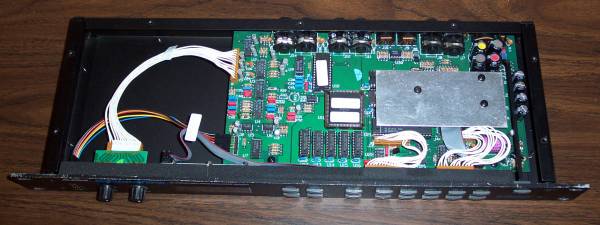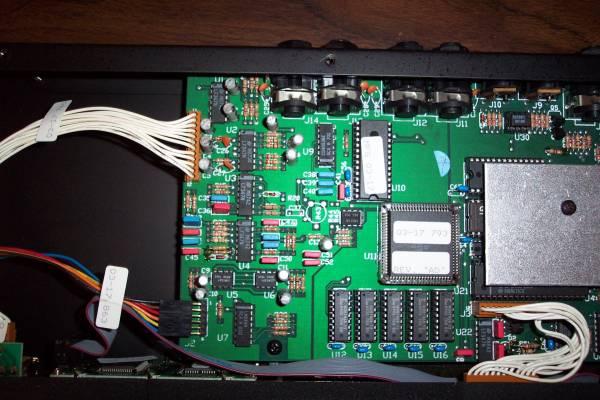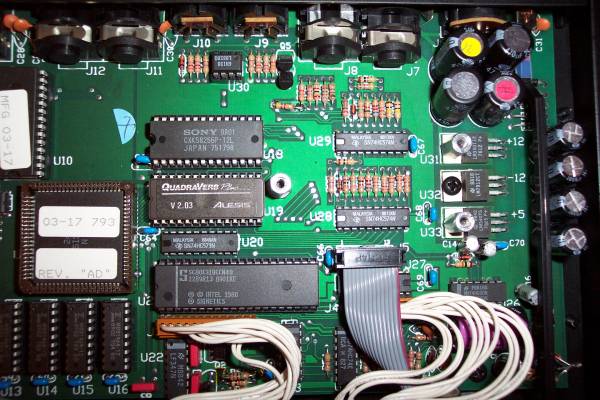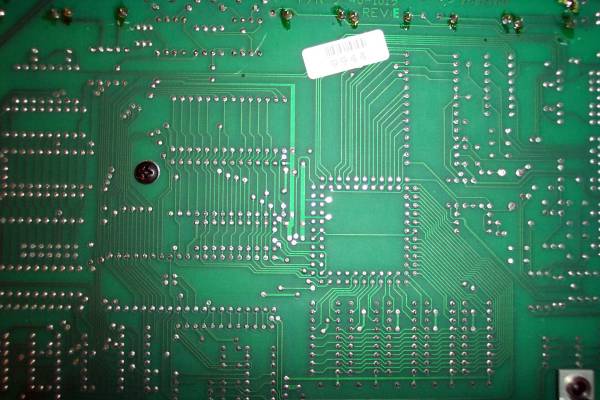Alesis Quadraverb Plus- owned from July 2002- present, bought for $95 or so.
Very common and very cheap, the Quadraverb is still a pretty useful processor.
(now take a deep breath...)
There are several different algorithms to choose from:
3-band parametric EQ (panning) > pitch > 800 ms delay > reverb type 1
leslie simulator > 800 ms delay > reverb type 1
graphic EQ > 1500 ms delay
5-band parametric EQ (panning) > pitch > 1500 ms multitap delay
3-band parametric EQ > reverb type 2
ring modulator > 800 ms delay > reverb type 1
resonator > 720 ms delay > reverb type 1
sampling
The 3-band parametric EQ has high and low shelving sections and a sweepable mid with a low frequency adjustable from 20 to 999 Hz, a mid frequency adjustable from 200 to 9999 Hz with bandwidth adjustable from .20 to 2.55 octaves, and a high frequency adjustable from 2000 to 18000 Hz. All parts can be adjusted +/- 14 db. The 5-band parametric EQ is similar, with the low-mid band adjustable from 20 to 500 Hz, the mid band adjustable from 200 to 9999 Hz, and the high-mid band adjustable from 2000 to 18000 Hz. The graphic EQ has 16, 32, 62, 126, 250, 500, 1000, 2000, 4000, 8000, and 16000 Hz bands, and it has an interesting way of using the characters of the 2x16 display to show the levels.
The pitch effect can be a mono/stereo chorus, mono/stereo flange, detune, or phase shifter. The input to the pitch section can be pre- or post- EQ. All the effects except detune share LFO rate and depth parameters. Flange and chorus also have feedback. Chorus includes LFO waveshape (triangle or square). Flange includes a "trigger flange" mode, which resets the phase of the LFO when the input reaches a certain level. Pitch detune only has a detune amount parameter, nothing else. It's not much of a pitch shift- it only detunes a little, it's not a harmonizer or anything. Of these I mostly use the stereo chorus and phase shifter.
The leslie simulator is fairly simple, with stereo separation, motor control (on or off), and speed (fast or slow) parameters. Like a real rotating speaker, the speed takes time to change, and when the motor control parameter turns the "motor" off- it slows to a stop.
The ring modulator is actually more like a frequency shifter in that it can output the up- and down-shifted parts separately. Modulator amount is from 1 to 300 Hz and the modulator seems to be a saw wave, although I don't think it's mentioned in the manual. The output mix and the delay/reverb input mix each consist of a mix of up and down signals, with an even ratio being equivalent to normal ring modulation. At low speeds, an even ratio makes a not very interesting tremolo sort of effect, and uneven ratios make nice sort of chorusing sounds, although different because it's a frequency shift instead of a pitch shift.
The resonator is actually 5 resonators, each one tunable over a 5-octave range (quantized to semitones). They can run continuously or be gated by midi signals. There's an overall resonator decay parameter that controls how much they resonate. This gets really interesting with midi control- the pitches of the resonators change polyphonically with note input. To work "properly", each resonator should be set to the same note, but nice effects can also be obtained by tuning them differently.
The delay section can be mono, stereo, or ping pong for all algorithms, plus multitap when using the 5-band parametric algorithm. The delay has 2 inputs: the first is set to either pre- or post- EQ, and the second is the pitch section (or ring modulator or whatever), and there's a variable mix between the 2 inputs. This part depends on the configuration selected. Stereo delays have independent delay times and feedback for each channel, with the maximum time for each channel being half the maximum mono time. The multitap delay has 8 separate taps, each with independent delay time, output level, panning, and feedback, with an overall feedback parameter. If several of the taps have high feedback then it can start to make noise on its own.
The reverb section has several algorithms to choose from- plate, room, chamber, hall, and reverse (regular reverb with reverse envelope). "Type 1" in the algorithm description above is the normal type, "type 2" in the 3-band EQ > reverb configuration uses different, more DSP-intensive algorithms to get better sound quality. "type 2" reverbs also include a chorus. There are 2 inputs here which depend on the algorithm used: the first can be pre- or post- EQ, pitch output, delay input mix, etc. The second is pitch output, delay output, etc., A variable mix of the two inputs goes into the reverb. Reverb parameters are pre-delay (up to 140 ms), pre-delay mix (variable mix of input and delayed signal), decay, diffusion, density, low and high frequency decay, gate (on or off), gate hold and release times, and gated level (output level when gate is "closed", I think). The hall algorithm is missing the density parameter and the reverse algorithm is missing the gate parameters. The reverb sounds nice, I use mainly the room and hall algorithms. Plate and chamber sound too metallic for my tastes, and reverse isn't all that useful. I haven't directly compared the normal algorithms to the higher-quality ones, so I don't know if there's really much of a difference in sound.
The output mix menu controls the levels of all the sections, with additional panning or tremolo of the EQ output for two of the configurations. I'm not sure how useful this feature really is- I've never done anything with it, but additional options are always nice to have.
The sampler is pretty useless- I've used it all of 2 times. Sample playback can be set to play once, loop, or be triggered by audio input. There is crude control over start and end points. It can be triggered by a button or midi gated. Sample pitch can be controlled via midi, but there is no other way to tune it. I don't know how but once I got it to make glitchy sounds. In this mode there are no other effects.
Already this is a pretty powerful processor, but there are also 8 mod sources. Any continuous controller can be used, plus pitch bend, aftertouch, midi note number, and note velocity. These can modulate any target parameter positively or negatively. Some of the modulations aren't very smooth (delay time in particular- tends to click a lot) but this opens up a lot of interesting possibilities.
Patches can be named (with a decent amount of interesting characters) and stored to 100 different locations. Generally I just program effects as I need them and don't bother storing patches. Factory patches can be reset from the machine, without resorting to hidden key combinations.
The interface is fairly easy to work with for a complex processor in a 1-rack space box. There are menus selected by reverb/delay/etc. buttons with two pairs of pressure-sensitive buttons to scroll through parameters and change values. The pressure sensitivity is a great alternative to a data slider or rotary encoder, though the editing of EQ parameters can get a bit tedious since they use such large values.
Inside it looks very clean and neatly assembled. There are several quality control stickers spread throughout. Apparently mine was assembled on March 20, 1989. The CPU is an 80C31, there are two CEM 3381 VCA chips, and a PCM54HP DAC. The effect processing is all done on a custom Alesis DSP chip.
The Quadraverb is such a common processor that I think a lot of people overlook some of its more interesting features. I've used the 5-band parametric EQ as a sort of crude morphing vocal formant filter, used the 3-band EQ as a decent-sounding resonant bandpass filter, used velocity to modulate phaser speed, the resonators and gated reverb to give a strange melodic sound to unpitched sounds, etc. And things get much more interesting when the output is plugged into a mixer input for feedback. It's easy then to use the EQ to filter the delay feedback path for an analog sound, get a more intense phaser effect, or get crazy feedback noises with the ring modulator or detune. It's not a TC Fireworx but it can do some great things if used creatively.
pictures:






back to synth index